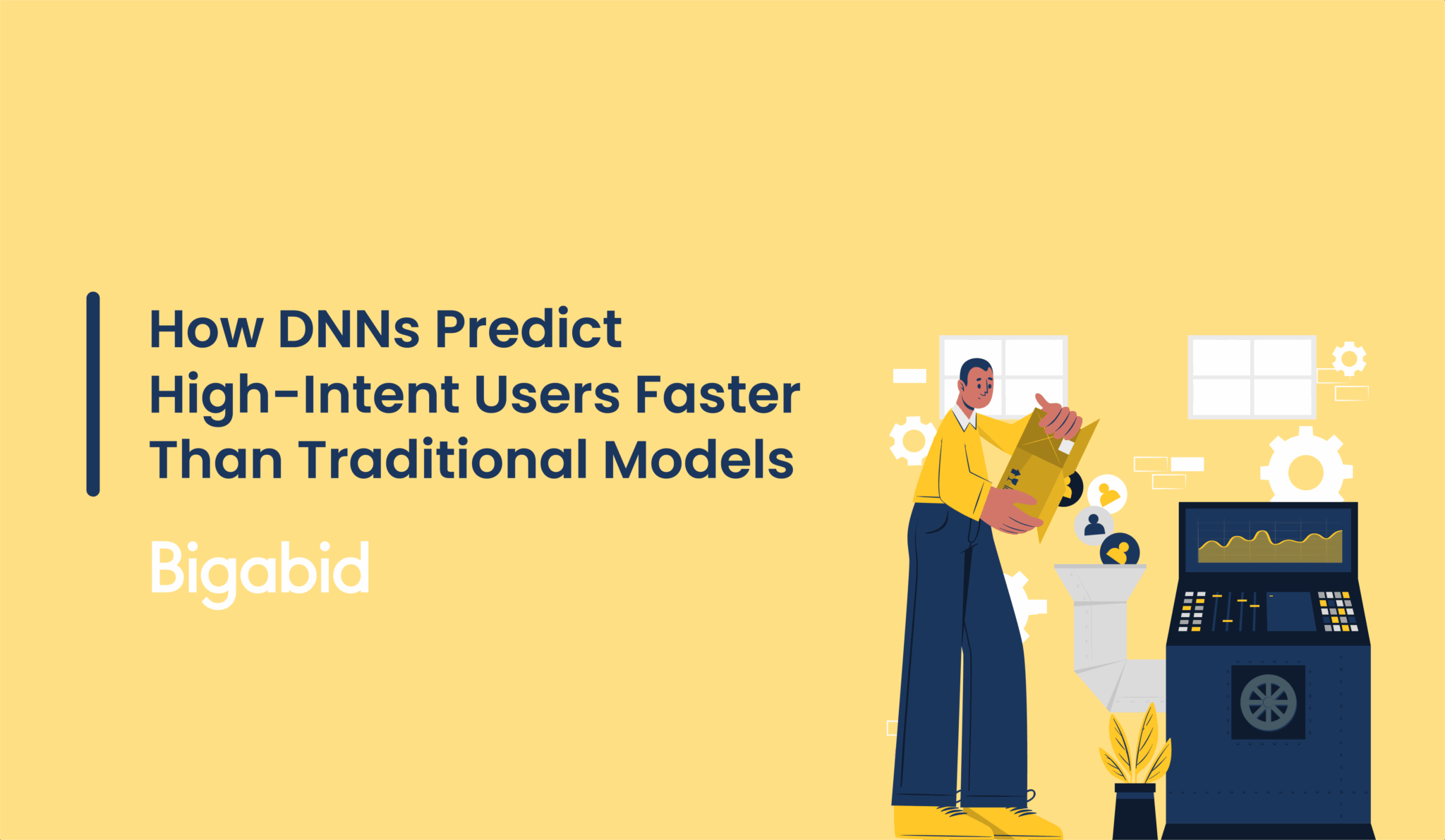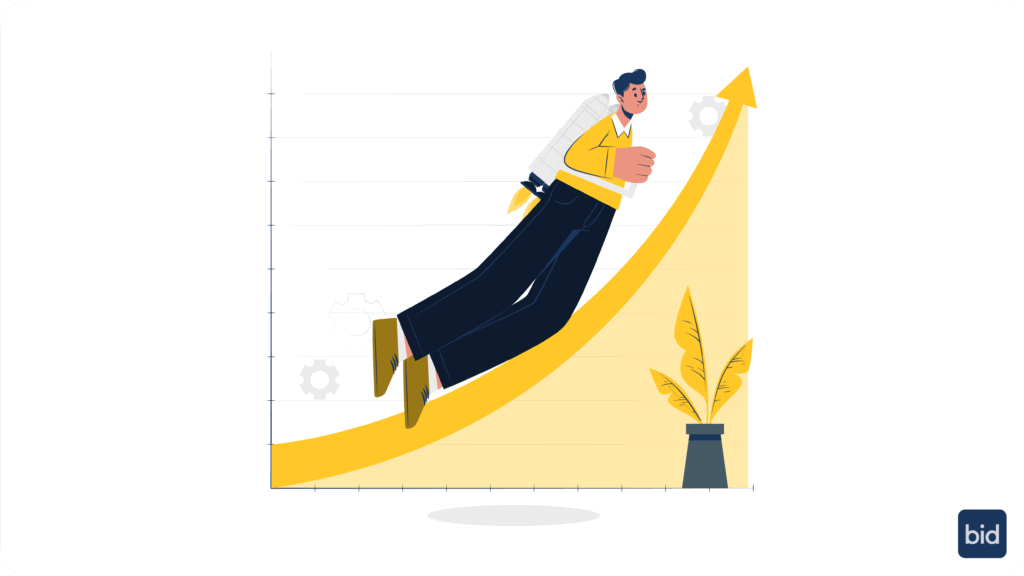
What if you could identify users ready to convert before they even know it themselves?
Picture this: It’s 3:47 PM on a Tuesday. Sarah opens her phone during a coffee break and starts browsing through apps. Within 10 milliseconds—before she’s even finished her first swipe—a Deep Neural Network has already processed her location data, recent app usage, purchase history, and dozens of other behavioral signals. It predicts with 89% confidence that she’s likely to install and make an in-app purchase within the next gaming app she encounters.
Meanwhile, traditional machine learning models are still processing her data from yesterday.
In mobile advertising, this speed difference isn’t just impressive—it’s the difference between profitable campaigns and budget waste. When you’re competing in real-time bidding environments where milliseconds determine winners and losers, the ability to predict user intent faster than your competitors becomes your most valuable asset.
This blog dives deep into how Deep Neural Networks are revolutionizing user intent prediction, offering mobile marketers the speed and precision needed to dominate programmatic campaigns. We’ll explore why traditional models are hitting their limits, how DNNs are breaking through those barriers, and what this means for your mobile user acquisition and mobile retargeting strategies.

Let’s be honest about something the industry doesn’t talk about enough: traditional machine learning models are choking on the complexity of modern mobile user behavior.
The problem starts with lag time. Most traditional models require batch processing—they collect data, analyze it in chunks, and then make predictions. This approach worked fine when we had simpler user journeys and fewer touchpoints. But today’s mobile users interact with dozens of apps daily, switch between devices seamlessly, and change their intent based on context we barely understand.
By the time a traditional model finishes analyzing a user’s behavior pattern, that user has already moved on. They’ve opened three new apps, clicked on two ads, and possibly made a purchase decision. The prediction arrives too late to influence their journey.
Traditional models also struggle with feature processing limitations. They excel at analyzing structured data—clear variables like “user clicked on ad” or “user spent 5 minutes in app.” But modern user intent emerges from the intersection of hundreds of subtle signals: the time of day combined with location data, recent app category preferences weighted against purchase history, device battery level correlated with engagement patterns.
These models typically use static decision trees or rule-based systems that can’t adapt to real-time behavioral shifts. They might predict that users who open fitness apps on Monday mornings have high intent for health-related purchases. But what happens when that same user opens the fitness app on a Friday evening after a stressful week? The context completely changes the intent, but traditional models can’t adjust their predictions dynamically.
Here’s where it hits your bottom line: in real-time bidding environments, every second of delay costs money. When you’re bidding on ad impressions, the auction happens in under 100 milliseconds. If your model takes 500 milliseconds to predict user intent, you’ve missed five auction opportunities. Multiply this across millions of daily bid requests, and you’re looking at substantial revenue leakage.
The attribution challenges get even more complex when users switch devices. Traditional models often treat mobile and desktop interactions as separate events. They miss the connected user journey where someone researches a gaming app on their laptop during lunch, then downloads it on their phone during the commute home. This fragmented view leads to undervaluing certain touchpoints and overvaluing others.
Scale limitations become apparent when processing millions of bid requests per second. Traditional models start breaking down—processing times increase exponentially, accuracy drops, and the whole system becomes unreliable precisely when you need it most.

Here’s where things get interesting from a technical perspective.
Deep Neural Networks approach user intent prediction fundamentally differently than traditional models. Instead of processing features sequentially or in predetermined combinations, DNNs analyze hundreds of behavioral signals simultaneously through multiple layers of interconnected nodes.
Think of it like this: a traditional model examines user behavior like reading a book—one page at a time, in order. A DNN reads the entire book at once, understanding how themes on page 50 connect to character development on page 200, while simultaneously analyzing the author’s writing style and predicting how the story will end.
In practical terms, DNNs create multi-layered feature extraction systems. The first layer might process basic signals like app category preferences and time of day. The second layer combines these with more complex patterns like cross-app usage sequences and seasonal behavior trends. Deeper layers identify subtle correlations that humans wouldn’t even think to look for—like how battery level influences purchase intent differently for gaming versus productivity apps.
The real breakthrough comes from real-time weight adjustment. Traditional models are static once deployed—they use the same decision rules until someone manually updates them. DNNs continuously learn and adapt. Every user interaction feeds back into the network, refining predictions and discovering new patterns. If users suddenly start behaving differently because of a new iOS update or cultural event, the DNN adapts its predictions within hours, not weeks.
Vectorization gives DNNs another massive advantage. They convert complex user behaviors into mathematical representations called embeddings. A user’s complete interaction history becomes a point in multi-dimensional space, and similar users cluster together. This allows for instant similarity matching—when a new user appears, the DNN immediately identifies their position relative to millions of previous users and predicts behavior based on the closest matches.
The speed advantage comes from parallel processing capabilities. While traditional models process features one at a time, DNNs examine everything simultaneously. Embedding layers contain pre-computed representations of users and apps, enabling instant matching without recalculating similarities from scratch.
Attention mechanisms help DNNs focus on the most predictive signals without getting distracted by noise. If a user’s recent gaming session is more indicative of current intent than their shopping behavior from last month, the attention mechanism automatically prioritizes the gaming signals.
GPU acceleration provides the final speed boost. Traditional models run on CPUs, processing information sequentially. DNNs leverage GPU architecture designed for parallel computation, handling thousands of calculations simultaneously.
When we talk about mathematical frameworks, DNNs assign intent likelihood on a probability scale from 0 to 1, but they also provide confidence intervals. A prediction of 0.85 with high confidence is more actionable than 0.90 with low confidence. Feature importance weighting reveals which signals matter most for different app categories—temporal patterns might be crucial for gaming apps, while location data drives utility app predictions.

So what does this mean for your day-to-day campaigns?
In user acquisition, DNNs enable lookalike modeling at unprecedented scale. Traditional lookalike audiences typically analyze 10-20 user characteristics. DNNs can identify patterns across thousands of behavioral dimensions, finding valuable user segments that human analysts would never discover. They might identify that users who engage with fitness apps on weekends, use productivity tools during weekday mornings, and have specific social media engagement patterns represent a highly valuable audience for a particular gaming app.
Creative-audience matching becomes remarkably sophisticated. DNNs can predict not just which users will install your app, but which specific ad creatives will resonate with different user segments. A user showing high intent for puzzle games might respond better to gameplay videos, while someone with productivity app affinity prefers static images highlighting features and benefits.
Bid optimization transforms from guesswork into precision. Instead of setting blanket CPI targets, DNNs adjust bids in real-time based on predicted user lifetime value. They might bid aggressively for a user showing signals of becoming a high-value player while reducing spend on users likely to churn within the first week.
For retargeting campaigns, DNNs revolutionize how we think about user re-engagement. Behavioral pattern recognition identifies users likely to re-engage versus permanent churners with remarkable accuracy. This isn’t just about recency—DNNs analyze hundreds of factors including app usage patterns, engagement depth, time spent in different app sections, and even external signals like seasonal behavior changes.
Optimal timing prediction takes retargeting beyond spray-and-pray approaches. DNNs identify when dormant users are most receptive to re-engagement messages. They might discover that lapsed gaming users are most likely to return on Sunday evenings, while productivity app users respond better to Tuesday morning messages.
Cross-app insights provide competitive intelligence that traditional models can’t match. By analyzing activity patterns across similar apps, DNNs make educated predictions about user behavior even for apps with limited historical data. If users typically engage with puzzle games for 3 months before switching genres, this insight informs both acquisition strategy and product development.
In programmatic environments, DNNs excel at DSP bidding scenarios where split-second decisions determine campaign success. They process bid request data, user profiles, and contextual information simultaneously, making optimal bid decisions faster than traditional models can even parse the request.
Social platform optimization requires understanding platform-specific user behaviors. Instagram users might respond to visual-heavy creatives during evening browsing sessions, while TikTok users prefer authentic, user-generated content during lunch breaks. DNNs adapt predictions for each platform’s unique user patterns and algorithm preferences.
Connected TV integration represents the next frontier. As mobile insights expand to CTV campaigns, DNNs create unified user profiles that span devices and channels, enabling consistent messaging and improved attribution across the entire customer journey.

Let’s talk numbers, because ultimately, your boss cares about results, not technical elegance.
Processing time comparisons reveal the most dramatic differences. Traditional machine learning models typically require 500-1000 milliseconds to process user signals and generate predictions. DNNs complete the same analysis in 10-50 milliseconds. In programmatic advertising, this speed difference translates directly to competitive advantage.
Throughput capacity shows even more impressive scaling. A well-optimized DNN system can handle over 10 million bid requests per second while maintaining prediction accuracy. Traditional models start degrading performance at much lower volumes, forcing advertisers to choose between speed and accuracy.
Accuracy improvements vary by vertical, but industry implementations commonly report meaningful improvements in intent prediction accuracy compared to traditional approaches. This translates to more efficient ad spend and higher campaign ROI across the board.
Real performance impact becomes clear in CPI improvements. Mobile gaming campaigns using DNN-powered targeting typically achieve substantial reductions in cost-per-install compared to traditional targeting methods. The improvement comes from better user identification, more precise bidding, and reduced wasted impressions on low-intent users.
ROAS optimization shows similar gains. E-commerce app campaigns often see significant improvement in return on ad spend when DNNs optimize bidding based on predicted customer lifetime value rather than simple conversion probability.
Scale benefits may be the most important advantage. Traditional models often require performance trade-offs as campaign volume increases. DNNs maintain consistent performance improvements regardless of scale—better data leads to better predictions, creating a virtuous cycle of improving performance.
Gaming apps see particularly strong results across different genres. Puzzle games benefit from DNNs identifying users with sustained engagement patterns, while casual games leverage predictions about session frequency and in-app purchase likelihood. Strategy games utilize complex user behavior modeling to identify players likely to progress through multiple game levels and make regular purchases.
E-commerce apps achieve dramatic improvements in transaction prediction accuracy. DNNs identify subtle behavioral signals that precede purchase decisions—browsing patterns, search queries, time spent in product categories, and seasonal shopping behaviors.
Subscription apps leverage DNN predictions to optimize free trial to paid conversion rates. By identifying users most likely to convert during trial periods, campaigns can focus budget on high-value prospects while developing specific retention strategies for different user segments.

Before you get too excited about implementing DNNs, let’s discuss what you need to know about practical deployment.
Data requirements represent the biggest consideration. DNNs need substantial training data to achieve optimal performance—typically millions of user interactions across multiple months. If you’re launching a new app or entering a new market, traditional models might perform better initially until sufficient data accumulates.
Integration complexity varies significantly depending on your current programmatic setup. DNNs work best when integrated directly into DSP bidding logic, requiring technical coordination between your team, DSP partners, and potentially additional infrastructure providers.
Privacy compliance becomes more complex with advanced modeling. DNNs can derive insights from anonymized data that traditional models couldn’t extract, but this capability requires careful consideration of GDPR, CCPA, and other privacy regulations. The good news is that DNNs often perform better with anonymized data than traditional models do with detailed personal information.
Testing frameworks need adjustment for DNN deployment. Traditional A/B testing approaches might miss subtle performance improvements that accumulate over time. DNNs often show gradual performance gains as they learn from additional data, requiring longer testing periods and more sophisticated statistical analysis.
Choosing the right technology partner becomes crucial for DNN success. Look for DSP providers with proven DNN implementations, not just companies claiming to use AI. Ask about model transparency, performance monitoring, and ongoing optimization capabilities.
Technical infrastructure requirements include GPU-accelerated computing resources, real-time data processing capabilities, and sophisticated model monitoring systems. Most advertisers work with specialized DSP partners rather than building internal DNN capabilities from scratch.
Support and optimization matter more with DNNs than traditional models. These systems require continuous monitoring, model refinement, and performance optimization. Choose partners who provide ongoing analytical support, not just technology access.

Early adoption of DNN-powered user acquisition provides significant competitive advantages, but these windows won’t remain open indefinitely.
Market saturation represents the biggest risk for late adopters. As more advertisers implement DNN targeting, the performance advantages of early adopters begin diminishing. Users become exposed to more sophisticated targeting from multiple advertisers, reducing the impact of any single campaign’s advanced targeting.
Learning curve benefits compound over time. DNNs improve performance as they process more data, meaning earlier implementation leads to better models. Competitors starting DNN adoption six months later face the challenge of catching up to models that have been learning continuously.
Budget efficiency improvements from DNN targeting create competitive pricing power. When your campaigns achieve better performance at lower costs, you can bid more aggressively for high-value audiences while maintaining profitability. This pricing advantage makes it harder for competitors using traditional targeting to compete effectively.
Future-proofing your UA strategy requires considering evolving privacy landscapes. DNNs adapt more effectively to cookieless environments because they rely on behavioral pattern recognition rather than explicit user tracking. As third-party data becomes less available, predictive modeling becomes more valuable.
Cross-platform integration enables unified user understanding across mobile, web, and connected TV channels. DNNs create holistic user profiles that improve targeting effectiveness across all channels, while traditional models often treat each platform separately.
The AI arms race in mobile advertising has already begun. Companies investing in DNN capabilities today are building sustainable competitive advantages. Those waiting for the technology to mature risk falling behind permanently as the performance gaps continue widening.

The mobile advertising landscape moves fast—and so should your targeting.
While your competitors rely on yesterday’s prediction models, Deep Neural Networks are already identifying your highest-intent users in real-time. Every millisecond of delay costs you conversions. Every missed signal costs you efficient spend. Every day you wait to implement advanced targeting is another day of competitive disadvantage.
At Bigabid, our advanced DSP platform doesn’t just predict user intent—it acts on it instantly. We process massive volumes of behavioral data in real-time, turning complex signals into profitable user acquisition outcomes that traditional models simply can’t match.
Our neural networks don’t just understand user behavior—they anticipate it. They identify high-value users before they even realize they’re ready to engage with your app. This isn’t futuristic technology; it’s working right now for mobile marketers who’ve made the smart choice to partner with us.
Whether you’re scaling user acquisition campaigns across competitive gaming categories or revitalizing dormant users through sophisticated retargeting sequences, our AI-driven platform transforms the chaotic complexity of modern mobile marketing into clear, actionable strategies.
Leading implementations in the industry demonstrate substantial improvements in campaign efficiency and performance scaling. More importantly, we’ve seen mobile marketers transform from reactive campaign managers into proactive growth strategists.
The question isn’t whether DNNs will revolutionize mobile user acquisition—they already have. The question is whether you’ll be leading this transformation or scrambling to catch up.
Ready to see what happens when cutting-edge neural networks meet mobile marketing expertise?
Get in touch with Bigabid today. Let’s turn your user acquisition challenges into competitive advantages.